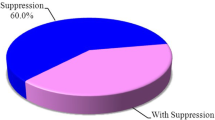Abstract
The aim of this study was to investigate the possible role of cochlear outer hair cell function with TEOAE and DPOAE tests in patients with normal hearing and tinnitus. 25 tinnitus patients with normal hearing sensitivity selected as study group. Control group consist of 50 normal hearing subjects without tinnitus. All subjects had thresholds below 25 dBHL at frequencies 250–8,000 Hz, tympanogram type A and normal acoustic reflex thresholds. TEOAE were recorded with click stimulus at 80 dB SPL at 1,000, 2,000, 3,000 and 4000 Hz. DPOAE were measured at frequencies 1,000–8,000 Hz and intensity of L1 55 dB SPL and L2 65 dB SPL. Amplitude of DPOAE and TEOAE were decreased in all frequencies in study group. There was significant difference regarding prevalence abnormal TEOAE and DPOAE between study group and control group. There was relationship between dysfunction of outer hair cells and tinnitus in subjects with normal hearing.
Similar content being viewed by others
References
Heller AJ (2003) Classification and epidemiology of tinnitus. Otolaryngol Clin N Am 36(2):239–248
Andersson G, Eriksson J, Lundh L-G, Lyttkens L (2000) Tinnitus and cognitive interferenceA stroop paradigm study. J Speech Lang Hear Res 43(5):1168–1173
Mrena R, Savolainen S, Kuokkanen JT, Ylikoski J (2002) Characteristics of tinnitus induced by acute acoustic trauma: a long-term follow-up. Audiol Neurotol 7(2):122–130
Puel J-L, Ruel JEROM, Guitton M, Wang J et al (2002) The inner hair cell synaptic complex: physiology, pharmacology and new therapeutic strategies. Audiol Neurotol 7(1):49–54
Fechter LD, Gd C, Rao D (2002) Chemical asphyxiants and noise. Noise Health 4(14):49
Shiomi Y, Tsuji J, Naito Y, Fujiki N, Yamamoto N (1997) Characteristics of DPOAE audiogram in tinnitus patients. Hear Res 108(1):83–88
Kaltenbach JA (2011) Tinnitus: models and mechanisms. Hear Res 276(1):52–60
Noreña AJ, Farley BJ (2013) Tinnitus-related neural activity: theories of generation, propagation, and centralization. Hear Res 295:161–171
Assaf S, Jamous NA, Hroot A, Tubishi K, Husban A, Hamasha K et al (2010) Otoacoustic emissions and tinnitus in normal hearing. JRMS 17(2):27–31
Kemp DT (2002) Otoacoustic emissions, their origin in cochlear function, and use. Br Med Bull 63(1):223–241
Snow JB (2004) Tinnitus: theory and management. PMPH-USA, Shelton
Ami M, Abdullah A, Awang MA, Liyab B, Saim L (2008) Relation of distortion product otoacoustic emission with tinnitus. Laryngoscope 118(4):712–717
Kim JH (2006) Tinnitus in noise-induced hearing loss. Korean J Aerosp Environ Med 16(1):9–14
Chéry-Croze S, Moulin A, Collet L, Morgon A (1994) Is the test of medial efferent system function a relevant investigation in tinnitus? Br J Audiol 28(1):13–25
Gouveris H, Maurer J, Mann W (2005) DPOAE-grams in patients with acute tonal tinnitus. Otolaryngol Head Neck Surg 132(4):550–553
Janssen T, Boege P, Oestreicher E, Arnold W (2000) Tinnitus and 2f1−f2 distortion product otoacoustic emissions following salicylate overdose. J Acoust Soc Am 107(3):1790–1792
Norton SJ, Schmidt AR, Stover LJ (1990) Tinnitus and otoacoustic emissions: is there a link? Ear Hear 11(2):159
Ceranic BJ, Prasher DK, Raglan E, Luxon LM (1998) Tinnitus after head injury: evidence from otoacoustic emissions. J Neurol Neurosurg Psychiatry 65(4):523–529
Smurzyński J, Hatzopoulos S, Kochanek K, Bartnik G, Raj-Koziak D et al (2012) The relationship between distortion product otoacoustic emissions and extended high-frequency audiometry in tinnitus patients. Part 1: normally hearing patients with unilateral tinnitus. Med Sci Monit 18(12):CR765
Granjeiro RC, Kehrle HM, Bezerra RL, Almeida VF, André LS, Oliveira CA (2008) Transient and distortion product evoked oto-acoustic emissions in normal hearing patients with and without tinnitus. Otolaryngol Head Neck Surg 138(4):502–506
Thabet EM (2009) Evaluation of tinnitus patients with normal hearing sensitivity using TEOAEs and TEN test. Auris Nasus Larynx 36(6):633–636
Favero M, Bento RF, Sanchez TG, Nascimento AF (2004) Contralateral suppression of otoacoustic emission in subject with tinnitus. Otolaryngol Head Neck Surg 131(2):P260
Igna CD, Schmidt LP, Smith M, Facchini L, Kang S (2004) Otoacoustic emissions in patients with tinnitus and normal hearing. Otolaryngol Head Neck Surg 131(2):P279
Assaf S, Jamous NA, Hroot A, Tubishi K, Husban A, Hamasha K et al (2010) Otoacoustic emissions and tinnitus in normal hearing. JRMS 17(2):27–31
Sztuka A, Pospiech L, Gawron W, Dudek K (2010) DPOAE in estimation of the function of the cochlea in tinnitus patients with normal hearing. Auris Nasus Larynx 37(1):55–60
Acknowledgments
We are very grateful to the patients and individuals who participated in this study. The research was supported by Hamadan University of Medical Sciences and Health Services.
Conflict of interest
The authors declared no potential conflicts of interest with respect to the research, authorship, and/or publicatiosn of this article.
Author information
Authors and Affiliations
Corresponding author
Rights and permissions
About this article
Cite this article
Emadi, M., Rezaei, M., Najafi, S. et al. Comparison of the Transient Evoked Otoacoustic Emissions (TEOAEs) and Distortion Products Otoacoustic Emissions (DPOAEs) in Normal Hearing Subjects With and Without Tinnitus. Indian J Otolaryngol Head Neck Surg 70, 115–118 (2018). https://doi.org/10.1007/s12070-015-0824-9
Received:
Accepted:
Published:
Issue Date:
DOI: https://doi.org/10.1007/s12070-015-0824-9




